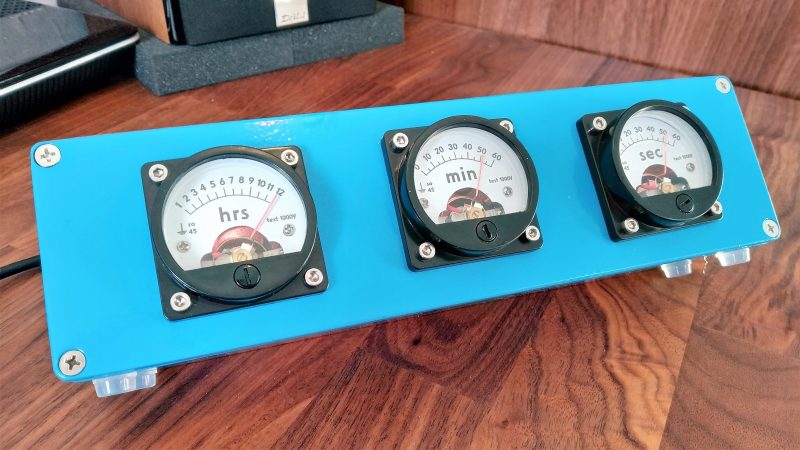Our community never seems to tire of clock builds. There are seemingly infinite ways to mark the passage of time, and finding unique ways to display it is endlessly fascinating.
There’s something about this analog voltmeter clock that really seems to have caught on with the Redditors who commented on the r/DIY thread where we first spotted this. [ElegantAlchemist]’s design is very simple – just a trio of moving coil meters with nice industrial-looking bezels. The meters were wired for 300 volts AC, so the rectifier and smoothing cap were removed and the series resistance was substituted for one more appropriate for the 0-5VDC range needed for the project. New dial faces showing hours, minutes and seconds were whipped up in Corel Draw, and everything was put into a sturdy and colorful aluminum “stomp box” normally used for effects pedals. An Arduino Nano and an RTC drive the meters with a nice, bouncy action. Simple, cheap to build, and a real crowd pleaser.
The observant reader will note a similarity to a clock we covered a while back. That one chose 3D-printed cases for an airplane instrument cluster look. We like the spare case design in [ElegantAlchemist]’s build, but wonder how this clock would look in a fine wood case.
















So, we have an analog phenomena, “time”, displayed in analog run by a digital computer…
B^)
Corel Draw? Now there’s a name I haven’t heard in a long long time. Literally decades; I think my parents installed Corel Draw 3 on their very first Dell desktop computer, back in the mid-90s. I had no idea it was still around.
And they’re still using the little balloon logo!
Sorry, just reminiscing.
I used to use Corel 6 and Corel 11 (the whole suite). Where I work it’s used for making some official graphical documentation.
Take it from someone who has a boss that’s stuck in the 80’s. Corel is still alive and well in 2019. I have to use Word Perfect and Quattro Pro on a daily basis.
No Multiplan?
yup. i love ve seeing the clamp cks.
great build! would like to see video say from 12:59:00 to 1:00:59 and see tjse seconds step
That is great! Too bad the meters can’t be full circles, though, for better resolution. And, maybe they could put all three on the same axis, and make the pointers different lengths to make it easy to distinguish between them. Hmmm.
I think you’re on to something – you should prototype it :)
Well, 270 degree “sweep” guages have been popular in aftermarket automotive…
That gets you closer to 360. B^)
Why not using an analog timing circuit for this? A Constant current source charges a cap and the buffered voltage is connected to the meter. Or you could use integrators. At midnight the whole thing is reset by the yours reaching the end and triggering a comparator.
If I use a CPU I have the time in digital format already and can display it like that.
A wood case like this? https://hackaday.io/project/6125-analog-amp-meter-clock
From 2015: https://qrznow.com/ham-clock/